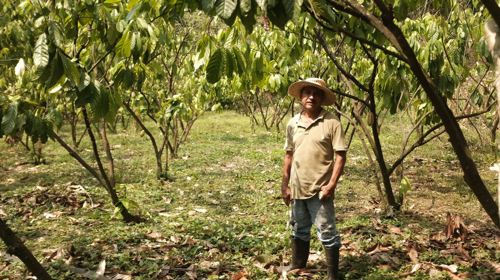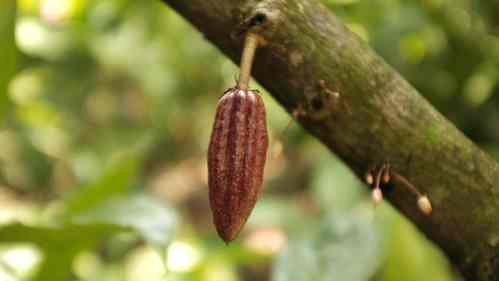17/10/23
Cocoa's revival in Mexico
In this last chronicle, our colleague Michaela will tell us more about her trip with the cocoa team in Mexico. ECOM’s operations in Mexico started in 1996, when offices were established in Tabasco followed by a processing plant in Veracruz, and most recently an office in Chiapas in 2010.
Over the years, cocoa production has drastically declined in Mexico, due to the spread of disease, old trees, and farmers opting to replant their farms with a more profitable and easier to manage crop such as palm or maize. In 2008, cocoa yields dropped by 46% due to the cocoa pod disease, moniliasis, resulting in the loss of prominence of cocoa. It was only until recently that efforts to revamp the production and maximize revenue for producers took place, from external groups and the Mexican government alike. Today, cocoa production is situated in Tabasco (70%), Chiapas (28%), Oaxaca (1%) and Guerrero (1%).

Michaela had the opportunity to meet with Juan Pacherre, the Head of Sustainability and Specialty Cocoa in Mexico. He showed her around the Chiapas region, and introduced her to various projects, producers, and of course, the beautiful cocoa pods.
According to Juan, the sustainability projects going on in Mexico are mainly funded byour largest clients to provide producers with more tolerant cocoa varieties to promote increased production. The refined Agrobusiness Model allows for the careful development and implementation of these varieties.
These sustainability projects were implemented in 2011 in Chiapas, and were spearheaded by Janett Gomez. Over the years, they have extended to Tabasco, and they have found success, reaching over 1,000 cocoa producers, creating the ability and knowledge to reach more farmers every year.
The next visit encompassed the Collection Garden within Finca Don Jorge, which is essentially a 13-hectare germplasm bank, with 17 different varieties of cocoa recognized for its quality and tolerance to diseases. It is here where various agronomic trials are tested to understand the best varieties for different climates of Mexico.

ECOM’s cocoa nursery is run and managed by an agronomist named Lino Garcia. He showed to Michaela the delicate process of extracting seeds from pods, preparing them for planting, then the grafting system that follows; overall taking only 4-5 months to produce a young tree. In the end, tolerant and high-quality cocoa trees thrived and were able to be dispersed to producers throughout the region. This nursery has an annual capacity to produce 500,000 cocoa plants and agroforestry trees per year.
ECOM is also offering producers training opportunities, new cocoa varieties, each contributing to a long-term improvement in income and a future for cocoa. Not only that, but the cocoa taste is greatly improving, especially with the increased popularity of specialty cocoa. Juan and his team are truly paving the future for cocoa in Mexico.
More news
Research
Click to read this articleCMPs significantly decreased deforestation in the most at-risk protected areas in Africa since 2000
This article explores collaborative management partnerships (CMPs) between state wildlife authorities and nonprofit conservation organizations to manage protected areas (PAs) have been used increasingly across Sub-Saharan Africa since the 2000s.
Insights
Click to read this articleThe Cocoa Price - A Key Factor for a Living Income for Farmers
SWISSCO has published a brief regarding perspectives and solutions regarding the price of cocoa and how it is relevant for a living income for farmers.
Insights
Click to read this articleECOM's Green Meter
We are pleased to announce the official rollout of our internal carbon calculator, Green Meter, which has been third-party reviewed by SustainCERT.
Research
Click to read this articleClimate-Smart Agriculture and Agroforestry in Cocoa
This guidance document was published by SWISSCO and focuses on approaches, financing needs and opportunities as well as providing high level guidance for stakeholders in the cocoa sector seeking to establish a broad range of actions that take the complexity of crop- and site-specific impacts of climate change and the realities of smallholder cocoa farmers into account.
Insights
Click to read this articleBeginners guide to Carbon Credits
This report provides an overview of the Voluntary Carbon Market (VCM), from what it is to the roles of carbon standards, governments, and Indigenous Peoples in the VCM.
Research
Click to read this articleGoogle Earth Engine, an innovative technology for forest conservation
This report explores how Google Earth Engine (GEE) can and has been used as a land monitoring tool to help enforce forest protection laws, co-authored by ECOM's SMS Manager Coffee, Thuan Sarzynski.
Research
Click to read this articleIncome study of cocoa producing households in Ghana
The Swiss Platform for Sustainable Cocoa (SWISSCO), in collaboration with the Ghana Cocoa Board (COCOBOD) and other partner institutions such as FiBL and HAFL, conducted a joint study to assess the current income situation of cocoa farming households in Ghana.
Stories
Click to read this articleLiving Income in Latin America: Towards a Prosperous Future
The Living Income Community of Practice hosted the annual in-person workshop and learning journeys in Colombia during the week of the 4th of November.
Research
Click to read this articlePrinciples for Regenerative Landscapes — Circular Bioeconomy Alliance
This report advocates for a transition to a circular bioeconomy supporting biodiversity and human well-being through 10 key principles.